Service de Conception de PCB
South-Electronic
Chez South-Electronic, nous sommes spécialisés dans la fourniture de services de conception de PCB de haute qualité, garantissant fiabilité, durabilité et amélioration des performances de vos produits. Nos conceptions sur mesure sont adaptées à vos besoins spécifiques, soigneusement élaborées pour optimiser les performances et la fiabilité. Avec huit lignes de production avancées, nous garantissons un traitement rapide et une livraison à temps, quelle que soit la taille de votre commande.
Pourquoi choisir South-Electronic ?
Chez South-Electronic, nous suivons des processus de contrôle qualité stricts, garantissant que chaque PCB répond aux normes les plus élevées de l’industrie, vous aidant à réduire les coûts de maintenance et à améliorer la satisfaction client. De la conception et du prototypage à la production en série, South-Electronic propose des solutions complètes, simplifiant votre chaîne d’approvisionnement et réduisant les coûts.
-
Design Personnalisé
Un design personnalisé pour répondre à vos besoins uniques.
Chez South-Electronic, nous comprenons que chaque projet est unique. C'est pourquoi nos services de conception de PCB sont personnalisés pour répondre à vos exigences spécifiques, en veillant à ce que chaque détail soit exécuté selon vos spécifications exactes. Cela améliore la performance et la fiabilité de vos produits. -
Satisfaction Garantie
Vous apprécierez la confiance que procure la collaboration avec une entreprise certifiée ISO9001.
Nous privilégions une communication claire et transparente et nous nous engageons aux normes les plus élevées pour garantir que vos PCB à 8 couches répondent non seulement à vos attentes, mais les surpassent en termes de performance, de durabilité et de précision. -
Service Tout-en-Un
En nous choisissant, vous bénéficiez d'une solution complète pour vos PCB, de la conception au prototypage, jusqu'à la production de masse.
Nous offrons un service tout-en-un, éliminant la complexité et les coûts liés à la gestion de plusieurs fournisseurs. -
Service Complet
Vous bénéficiez d'une satisfaction totale grâce à notre large gamme d'équipements.
Nous disposons d'une large gamme de capacités de traitement de PCB. Du design à la livraison, nous avons l'équipement et les processus nécessaires pour garantir que votre commande soit parfaitement réalisée. -
Livraison Rapide
Respectez vos délais grâce à nos délais d'exécution rapides.
Notre production optimisée garantit des délais rapides, pour que vous receviez vos produits sans retard.
Projets Connexes Réalisés
Avis Clients
Questions Fréquentes
Questions les Plus Fréquemment Posées
Envoyez-nous un message
Plus vous remplissez de détails, plus nous pourrons avancer rapidement à l’étape suivante.
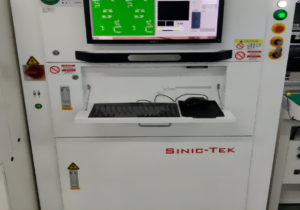
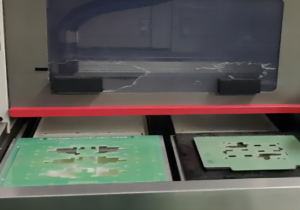
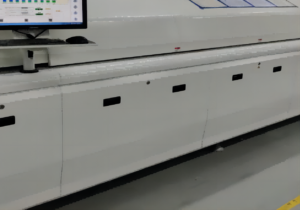
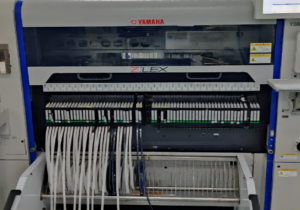
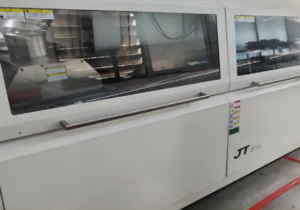
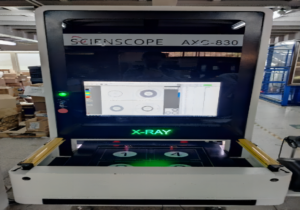

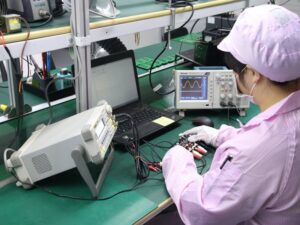

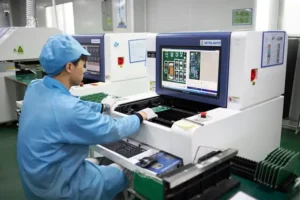



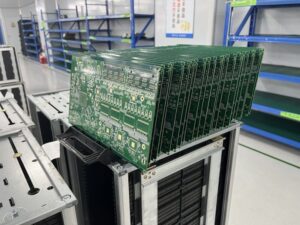

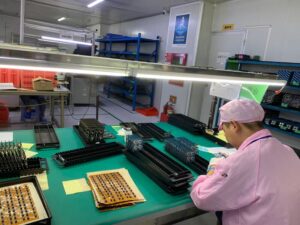




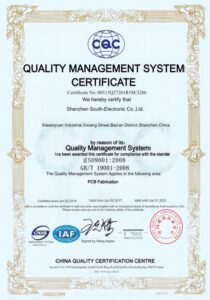









Guide Complet pour le Conception de PCB
Sommaire
Chapitre 1
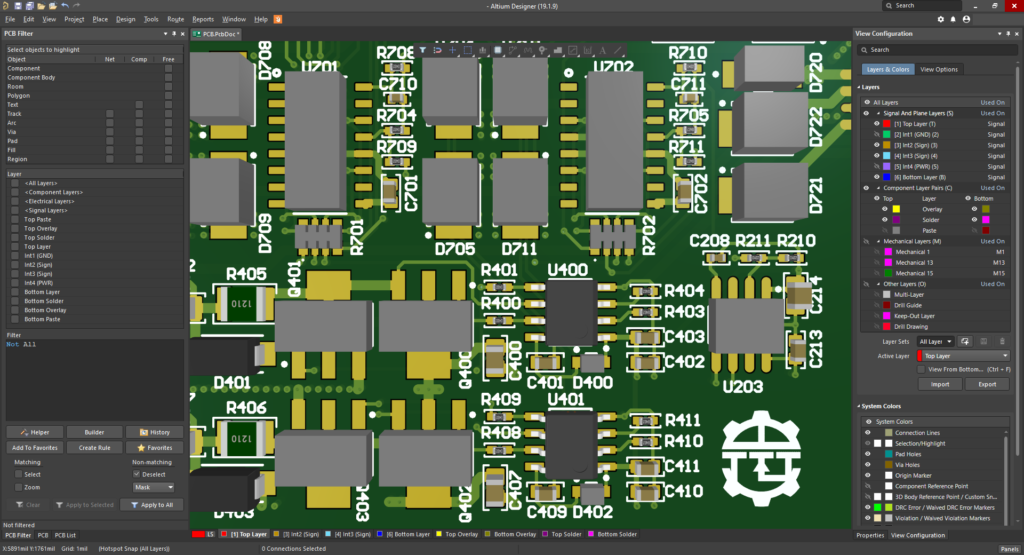
Introduction à la Conception de PCB
La conception de PCB est une étape cruciale dans le monde de l’électronique. C’est la base de presque tous les appareils électroniques, des gadgets simples aux machines complexes. Si vous êtes ingénieur ou amateur souhaitant créer des systèmes électroniques efficaces et fiables, il est essentiel de connaître la conception de PCB.
Qu’est-ce que la Conception de PCB ?
La conception de PCB est le processus de planification de l’agencement physique des composants et des connexions électriques sur une carte de circuit imprimé. Cela signifie disposer les composants électriques de manière logique et efficace, puis tracer les connexions électriques entre eux.
Une carte de circuit imprimé comporte généralement plusieurs couches, y compris des couches de cuivre pour les chemins des circuits, une couche de substrat pour l’isolation, et une couche de masque de soudure pour la protection. Cette superposition permet de miniaturiser les circuits, ce qui signifie que vous pouvez intégrer des composants électroniques avancés dans de petits espaces.
Principaux aspects de la conception de PCB :
- Placement des composants : Déterminer où placer les composants pour qu’ils fonctionnent bien et s’adaptent.
- Traçage des pistes : Concevoir les chemins physiques que suivront les signaux électriques.
- Vérification des règles de conception (DRC) : S’assurer que votre conception respecte les capacités de fabrication et les meilleures pratiques.
- Intégrité du signal : Maintenir la qualité des signaux électriques à mesure qu’ils traversent la carte.
- Gestion thermique : Gérer la chaleur générée par les composants pour éviter les dommages ou les pannes.
Pourquoi la Conception de PCB est Importante en Électronique
La conception de PCB est essentielle pour plusieurs raisons :
- Fiabilité et fonctionnalité : Une bonne conception de PCB garantit que vos appareils électroniques fonctionnent sans défaillance. Une conception soignée minimise les risques de problèmes ou d’interférences, rendant votre appareil plus fiable.
- Taille et compacité : Une bonne conception permet d’intégrer des composants électroniques dans des espaces réduits. Cela signifie que vous pouvez créer des appareils plus petits et plus fonctionnels, comme les smartphones et les dispositifs portables.
- Efficacité des coûts : Optimiser la conception de PCB permet d’économiser sur les coûts de fabrication. Une disposition efficace utilise moins de matériaux et augmente la production par cycle, réduisant ainsi les coûts.
- Optimisation des performances : Une conception bien pensée minimise les retards et les interférences des signaux, ce qui est crucial pour les applications à haute vitesse et haute fréquence. Cela améliore l’efficacité et les performances de vos appareils.
- Gestion thermique : Une bonne conception aide à dissiper la chaleur en plaçant les composants de manière optimale et en concevant des chemins de dissipation thermique efficaces. Cela garantit la sécurité et la durabilité de vos appareils.
- Évolutivité et flexibilité : Une conception de PCB bien faite facilite les modifications et les mises à jour. Cela est important pour les itérations de conception et pour augmenter la production en cas de succès commercial.
En résumé, la conception de PCB joue un rôle majeur. Elle influence la performance, le coût et la taille de vos produits électroniques. Si vous souhaitez créer des produits électroniques innovants et fiables, vous devez maîtriser la conception de PCB.
Chapitre 2
Comprendre les Bases de la Conception de PCB
La conception de PCB constitue le cœur de la création de systèmes électroniques efficaces et fiables. En maîtrisant les bases de la conception de PCB, les ingénieurs et les concepteurs peuvent créer des circuits répondant à des critères spécifiques de performance, de taille et de coût.
Composants de la Conception de PCB
Lors de la conception d’un PCB, plusieurs composants et concepts clés doivent être pris en compte pour garantir une disposition efficace :
Substrat (Substrate) :
Le substrat est le matériau de base du PCB, fournissant un support mécanique pour l’ensemble de la carte. Il est généralement fabriqué en fibre de verre (FR4) et agit comme une couche isolante entre la carte et ses composants.
Couches de cuivre (Copper Layers) :
Les couches de cuivre sont là où les circuits électriques sont gravés. Un PCB peut comporter plusieurs couches de cuivre pour des conceptions complexes, avec des pistes formant les chemins pour les signaux électriques.
Masque de soudure (Solder Mask) :
C’est un revêtement protecteur appliqué sur les couches de cuivre, empêchant les courts-circuits et protégeant contre les dommages environnementaux. Il donne au PCB sa couleur verte caractéristique, bien que d’autres couleurs soient disponibles.
Sérigraphie (Silkscreen) :
La sérigraphie ajoute des textes et des symboles au PCB pour l’identification des composants, des points de test et d’autres indicateurs. Elle facilite les processus d’assemblage et de débogage.
Pistes et pastilles (Traces and Pads) :
Les pistes sont les chemins conducteurs, similaires aux fils, qui relient les différents composants sur le PCB. Les pastilles offrent les surfaces où les composants sont soudés.
Via :
Les vias sont de petits trous qui permettent les connexions électriques entre différentes couches d’un PCB multicouche. Ils sont remplis de matériau conducteur pour faciliter la connectivité inter-couches.
Composants (Components) :
Cela inclut toutes les pièces électroniques soudées sur le PCB, telles que les résistances, condensateurs, puces, connecteurs, et plus encore. Le placement et l’orientation appropriés de ces composants sont essentiels pour le bon fonctionnement du circuit.
Règles et contraintes de conception (Design Rules and Constraints) :
Ce sont les directives établies pour garantir que la conception est réalisable pour la fabrication et fonctionne correctement dans des conditions de fonctionnement spécifiées. Elles incluent les espacements, les tailles et les limites électriques.
Types de PCB
Les PCB existent en différents types, chacun adapté à des applications et des exigences de conception spécifiques. Voici quelques types courants :
PCB simple face (Single-Sided PCBs) :
Ils comportent une seule couche de cuivre et sont le type de PCB le plus simple. Ils sont économiques et faciles à fabriquer, ce qui les rend idéaux pour les circuits simples ou de faible densité comme les calculatrices et les alimentations électriques.
PCB double face (Double-Sided PCBs) :
Dotés de couches de cuivre des deux côtés, ces PCB permettent des circuits plus complexes car les composants et les routes peuvent être placés sur les deux faces. Ils sont couramment utilisés dans la surveillance de puissance, les contrôles industriels, et les applications automobiles.
PCB multicouches (Multi-Layer PCBs) :
Composés de trois couches de cuivre ou plus, ces PCB sont empilés avec des couches isolantes entre elles. Ils conviennent aux produits technologiques avancés, tels que les ordinateurs et les instruments aérospatiaux, en raison de leur capacité à intégrer des circuits complexes dans un espace limité.
PCB rigides (Rigid PCBs) :
Ces PCB ont un matériau de substrat solide qui ne fléchit pas. Ils sont utilisés dans les situations où le PCB doit rester stable et conserver sa forme, comme dans les ordinateurs de bureau et l’infrastructure réseau.
PCB flexibles (Flexible PCBs) :
Fabriqués en substrats plastiques flexibles, ces PCB peuvent se plier et s’adapter à des espaces compacts ou irréguliers. Ils sont souvent utilisés dans les dispositifs portables, les appareils mobiles et les électroniques flexibles.
PCB rigides-flexibles (Rigid-Flex PCBs) :
Combinant les caractéristiques des PCB rigides et flexibles, ceux-ci permettent à certaines sections de fléchir tandis que la carte principale reste rigide. Ils sont idéaux pour les applications nécessitant à la fois flexibilité et durabilité contrôlée.
PCB haute fréquence (High-Frequency PCBs) :
Conçus pour gérer des signaux dans la gamme des gigahertz, ces PCB sont utilisés dans des applications telles que les systèmes de communication et les satellites, où l’intégrité des signaux à haute fréquence est cruciale.
Comprendre ces composants et types est essentiel pour toute personne impliquée dans la conception de PCB, car cela ouvre la voie à la création de systèmes électroniques efficaces, économiques et performants.
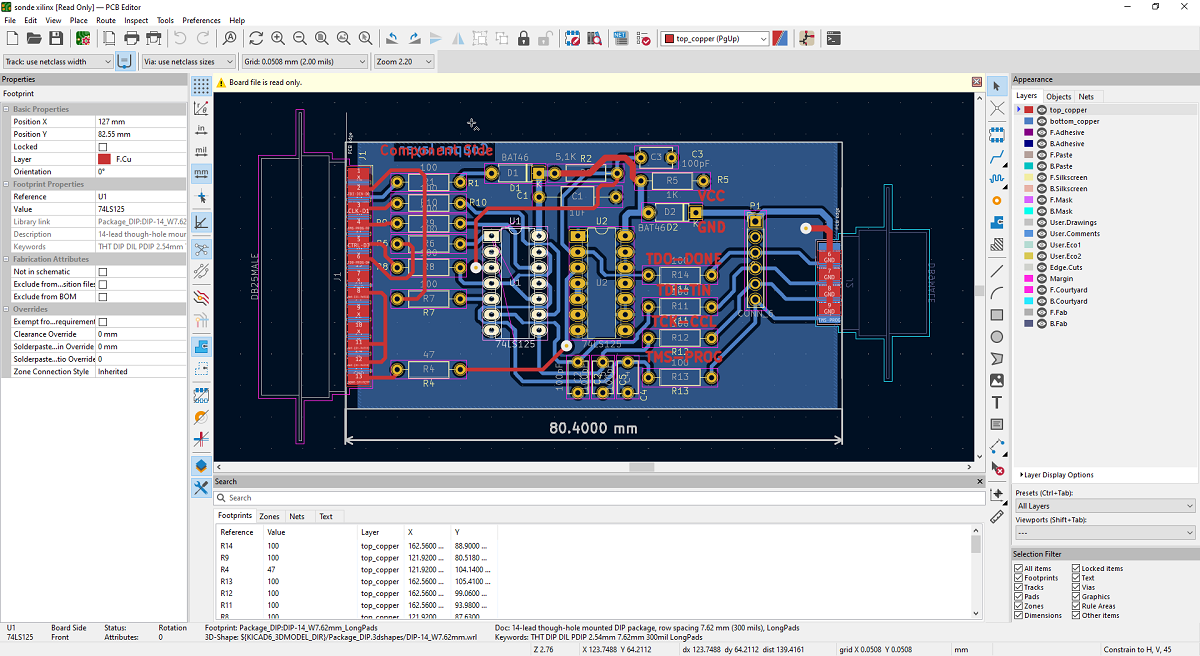
Chapitre 3

Logiciels Essentiels pour la Conception de PCB
Dans le processus de conception de PCB, disposer des bons outils logiciels est crucial. Ces outils simplifient non seulement le processus de conception, mais permettent également de simuler et de tester le design avant la production réelle. Utiliser un logiciel de conception de PCB adapté peut considérablement améliorer la précision, l’efficacité et la créativité dans vos projets.
Aperçu des Outils de Conception de PCB Populaires
De nombreux outils de conception de PCB sont disponibles, chacun répondant à des besoins et niveaux d’expertise différents. Voici un aperçu de certains logiciels de conception largement utilisés :
Altium Designer :
Réputé pour son ensemble de fonctionnalités complètes, Altium Designer est apprécié par les ingénieurs professionnels pour les projets complexes et de grande envergure. Il offre une gestion robuste des bibliothèques et des outils de simulation avancés, ce qui le rend adapté aux conceptions haut de gamme.
Eagle (Easily Applicable Graphical Layout Editor) :
L’un des outils les plus populaires parmi les amateurs et les professionnels, Eagle est reconnu pour son interface conviviale et sa flexibilité. Il propose des options d’édition puissantes et une grande bibliothèque de composants. Désormais propriété d’Autodesk, il bénéficie d’une intégration accrue avec d’autres outils de conception.
KiCad :
Un outil de conception gratuit et open-source, KiCad gagne en popularité grâce à ses capacités qui rivalisent avec les logiciels commerciaux. Il prend en charge des conceptions complexes à plusieurs couches et bénéficie d’un solide soutien communautaire pour des bibliothèques et modules supplémentaires.
OrCAD :
Cet outil convient à une large gamme de projets, des plus simples aux plus complexes. Connu pour ses puissantes capacités de simulation, OrCAD est prisé dans les environnements académiques et industriels où une précision de conception électrique approfondie est requise.
Proteus :
Proteus offre une grande facilité d’utilisation et est particulièrement populaire pour l’enseignement, l’éducation et les projets débutants. Il permet une simulation visuelle en parallèle de la conception de PCB, aidant ainsi à comprendre le comportement du circuit avant sa mise en œuvre réelle.
DipTrace :
Idéal pour créer des conceptions simples à complexes, DipTrace propose une interface intuitive et un flux de travail simplifié. Il prend en charge l’aperçu en 3D, aidant les concepteurs à visualiser le produit final avec plus de précision.
DesignSpark PCB :
Destiné à la fois aux débutants et aux concepteurs expérimentés, DesignSpark est gratuit et offre un nombre illimité de pads et de nœuds. Il dispose d’une grande bibliothèque et d’une interface facile à apprendre, ce qui en fait une solution idéale pour les projets moins complexes.
Chapitre 4
Meilleures Pratiques pour la Conception de PCB
Pour créer des conceptions performantes, fiables et facilement fabricables, il est essentiel de connaître les meilleures pratiques pour la conception des circuits imprimés (PCBs). Deux aspects clés de la conception de PCB qui influencent ces facteurs sont l’intégrité du signal et la distribution de l’alimentation.
Conception pour l’Intégrité du Signal
L’intégrité du signal consiste à maintenir des signaux électriques propres lorsqu’ils traversent un PCB. Une mauvaise intégrité du signal peut entraîner des pertes de données, du bruit et des circuits défaillants. Voici quelques bonnes pratiques pour une intégrité du signal optimale :
- Réduisez la longueur des pistes : Des pistes plus courtes ont moins de résistance, moins d’inductance et moins de risques de dégradation des signaux. Gardez les signaux haute vitesse aussi courts que possible.
- Contrôlez l’impédance : Concevez des pistes avec une impédance contrôlée, en particulier pour les circuits haute fréquence, afin d’éviter les réflexions et les pertes. L’adaptation d’impédance garantit une transmission efficace des signaux.
- Utilisez judicieusement les plans de masse : Les plans de masse solides offrent un point de référence pour les signaux, réduisent le bruit et améliorent le fonctionnement global du système électrique. Ils aident également à réduire les interférences électromagnétiques (EMI).
- Séparez les signaux : Éloignez les signaux haute vitesse des signaux basse vitesse ou haute intensité pour éviter les interférences. Utilisez des pistes de masse ou des zones de cuivre entre différents types de signaux.
- Évitez de traverser les vias : Trop de vias peuvent perturber le flux des signaux et augmenter l’inductance. Utilisez moins de vias pour les signaux critiques et gardez les itinéraires aussi droits que possible.
- Routage correct des paires différentielles : Pour les signaux transmis en paires différentielles, maintenez l’espacement et la longueur des paires égaux afin de préserver l’équilibre et la propreté des signaux.
- Terminez correctement les signaux : Utilisez les techniques de terminaison appropriées (comme les résistances en parallèle ou en série) pour adapter l’impédance de la ligne et éviter les réflexions.
- Surveillez les chemins de retour des signaux : Assurez-vous que les chemins de retour des signaux sont directs et ininterrompus. Placez des vias de masse près des vias de signaux pour garantir des chemins de retour efficaces.
Directives pour la Distribution de l’Alimentation
Un bon design de distribution d’alimentation est essentiel pour fournir une alimentation stable à toutes les parties, réduire les chutes de tension et minimiser la chaleur. Voici quelques directives pour une bonne distribution de l’alimentation :
- Utilisez des pistes d’alimentation larges : Des pistes plus larges ou des zones de cuivre peuvent transporter plus de courant avec moins de résistance, ce qui réduit les chutes de tension et la chaleur.
- Utilisez un plan d’alimentation dédié : Un plan d’alimentation dédié permet de distribuer uniformément l’alimentation et empêche les fluctuations de tension. Il offre également un chemin à faible inductance à travers tout le circuit.
- Utilisez des condensateurs de découplage : Placez des condensateurs de découplage près des broches d’alimentation des circuits intégrés pour filtrer les pics de tension et fournir une alimentation instantanée lors d’événements rapides.
- Adoptez une topologie en étoile pour les branches : Utilisez une topologie en étoile pour ramifier les lignes d’alimentation à partir d’un point central, ce qui réduit la surface des boucles de courant et diminue le bruit sur les lignes d’alimentation et de masse.
- Reliez l’alimentation et la masse avec des vias : Utilisez des vias pour connecter les plans d’alimentation et de masse, réduisant ainsi l’inductance dans les boucles et assurant des chemins de masse solides.
- Évitez les rebonds de masse : Ne laissez pas différentes parties de la carte qui transportent un courant important partager le même chemin de masse. Cela évite les changements dynamiques de tension qui perturbent la masse.
- Prenez en compte la chaleur : Répartissez les composants d’alimentation pour mieux gérer la chaleur. Utilisez des dissipateurs thermiques ou des vias thermiques pour les pièces générant beaucoup de chaleur.
- Vérifiez l’intégrité de l’alimentation : Utilisez des outils de simulation pour vérifier l’intégrité de l’alimentation afin de vous assurer que la tension reste dans les limites requises sur toute la carte.
En suivant ces meilleures pratiques dans vos conceptions de PCB, vous pouvez obtenir une bonne intégrité du signal et une distribution d’alimentation efficace, garantissant ainsi le bon fonctionnement de vos produits électroniques dans diverses conditions.

Chapitre 5
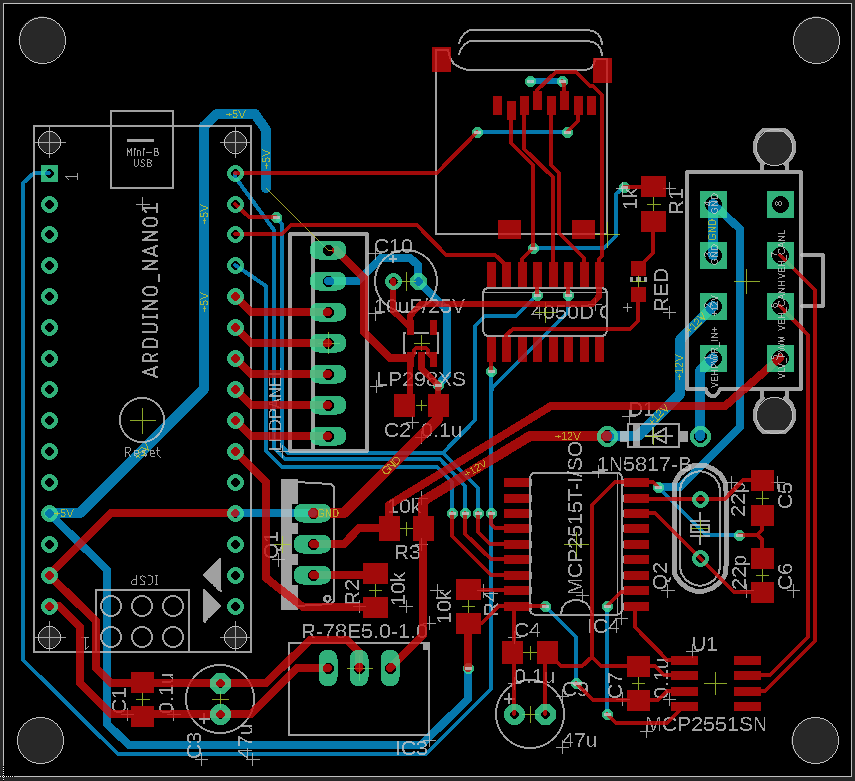
Stratégies de Placement des Composants
Un placement correct des composants est une étape cruciale dans la conception des circuits imprimés (PCBs), influençant directement les performances électriques, la gestion thermique et la fabricabilité de la carte. Mettre en œuvre des stratégies de placement des composants améliore la fonctionnalité et la fiabilité globales du circuit.
Importance du Placement Stratégique des Composants
Intégrité du signal :
Un placement stratégique minimise la longueur des chemins de signal, réduisant ainsi les retards potentiels, les réflexions et le bruit, améliorant ainsi l’intégrité et les performances du signal.
Gestion thermique :
Un placement efficace des composants favorise la dissipation de chaleur. Un agencement approprié empêche la surchauffe, garantit que les composants fonctionnent dans des plages de température sûres et prolonge la durée de vie de la carte.
Facilité d’assemblage :
Un placement organisé des composants simplifie le processus d’assemblage, réduit les erreurs et diminue les coûts de production. Une séparation claire et un agencement logique permettent aux lignes d’assemblage automatisées de fonctionner efficacement.
Réduction des interférences électromagnétiques (EMI) :
Un placement minutieux minimise les interférences croisées et électromagnétiques en maintenant des distances optimales entre les composants et en fournissant des chemins de mise à la terre efficaces.
Maintenance et test :
Un design pensé pour la maintenance permet un accès facile aux composants critiques pour les tests et les réparations, ce qui est crucial pour les applications complexes ou à haute fiabilité.
Optimisation de l’espace :
Un placement stratégique maximise l’utilisation de l’espace disponible, permettant la miniaturisation des dispositifs électroniques sans compromettre leur fonctionnalité.
Conseils pour un Placement Efficace des Composants
Priorisez les composants clés :
Commencez par placer les composants clés tels que les microcontrôleurs, processeurs ou connecteurs, car ils déterminent souvent l’agencement du reste des composants.Regroupez les composants associés :
Regroupez les composants par fonction (par exemple, circuits analogiques, logique numérique) pour simplifier le routage et réduire la distance des chemins de signal. Cette stratégie aide également à une distribution efficace de l’alimentation.Maintenez la cohérence d’orientation :
Alignez les composants dans une orientation uniforme pour faciliter l’inspection et l’assemblage. Une orientation cohérente réduit également le risque d’erreurs lors du soudage.Optimisez pour le routage des traces de signal :
Positionnez les composants pour minimiser la longueur des traces pour les signaux haute vitesse. Placez les composants de manière à permettre un routage direct sans courbures ou vias inutiles.Considérez les composants sensibles à la chaleur :
Gardez les composants sensibles à la chaleur éloignés des dispositifs à haute puissance. Fournissez un espace adéquat ou des dissipateurs thermiques pour améliorer la dispersion thermique.Suivez les recommandations des fabricants :
Respectez les recommandations de disposition des fiches techniques des composants, en particulier concernant les pads thermiques et les condensateurs de découplage pour les circuits intégrés.Préparez-vous aux itérations de conception :
Laissez de l’espace pour des ajustements et ajouts de composants afin d’accommoder les changements de conception sans réorganisation majeure.Maintenez les espacements :
Assurez un dégagement électrique suffisant entre les pads et traces opposés, comme l’exigent les règles de conception, pour éviter les courts-circuits ou arcs électriques.Contraintes physiques :
Tenez compte de l’assemblage mécanique final, en réservant des zones pour les trous de montage, connecteurs de bord et autres exigences structurelles.Revue et simulation :
Utilisez des logiciels pour simuler les impacts du placement des composants. Cette pratique permet d’identifier les problèmes potentiels avant la phase de fabrication.
En appliquant ces stratégies, les concepteurs peuvent améliorer l’efficacité de leurs conceptions de PCBs, aboutissant à des circuits mieux performants avec une fiabilité et une fabricabilité accrues.
Chapitre 6
Techniques de Routage pour une Conception Efficace de PCB
Le routage est une phase critique dans la conception de PCB, où les connexions entre les composants sont établies physiquement à travers un réseau de pistes. Les techniques de routage efficaces sont essentielles pour optimiser les performances, réduire le bruit et assurer l’intégrité du signal.
Différentes Méthodes de Routage Expliquées
Routage Manuel :
- Description : Le concepteur place manuellement chaque piste sur le PCB. Cette méthode offre un contrôle accru sur les chemins des pistes, essentiel pour les signaux sensibles et haute vitesse.
- Applications : Utilisé lorsque la précision est primordiale, comme dans les conceptions RF ou les cartes à haute densité.
Routage Automatique (Autorouting) :
- Description : Les algorithmes logiciels déterminent automatiquement les chemins optimaux pour les pistes. Le routage automatique est rapide et convient aux conceptions moins complexes.
- Applications : Idéal pour les circuits simples ou le routage préliminaire avant un raffinement manuel.
Routage en Paires Différentielles :
- Description : Implique le routage d’une paire de signaux complémentaires ensemble avec un espacement et une longueur constants pour assurer l’intégrité du signal. Cela permet de minimiser le bruit et le couplage.
- Applications : Crucial pour les interfaces haute vitesse comme HDMI, USB et Ethernet.
Appariement de Longueur (Length Matching) :
- Description : Assure que les pistes transportant des signaux qui doivent arriver simultanément à leur destination aient des longueurs égales. Cela évite les problèmes de synchronisation dans les circuits haute fréquence.
- Applications : Essentiel dans les systèmes de bus mémoire comme les circuits DDR.
Routage à Impédance Contrôlée :
- Description : Garantit que les pistes ont des valeurs d’impédance spécifiques en contrôlant leur largeur, leur séparation par rapport aux autres pistes et leur proximité avec les plans de masse.
- Applications : Utilisé dans les lignes de signaux RF et haute fréquence.
Soudure de Vias (Via Stitching) :
- Description : Consiste à placer plusieurs vias le long d’une piste pour connecter les plans de masse ou répartir les charges thermiques, aidant à réduire l’EMI et les boucles de masse.
- Applications : Commun dans les PCBs multicouches avec des préoccupations d’interférences électromagnétiques élevées.
Éviter les Erreurs Courantes de Routage
Évitez les Angles Aigus :
- Erreur : Utiliser des angles aigus (moins de 90 degrés) dans les pistes peut entraîner des réflexions de signal et des problèmes de fabrication.
- Solution : Utilisez des angles de 45 degrés pour assurer un flux de signal fluide.
Minimisez l’Utilisation de Vias :
- Erreur : Une utilisation excessive de vias peut augmenter l’inductance et la résistance, affectant l’intégrité du signal.
- Solution : Planifiez le routage pour minimiser le nombre de vias, particulièrement dans les lignes haute fréquence.
Évitez les Pistes Parallèles :
- Erreur : Les pistes parallèles peuvent provoquer des interférences croisées, surtout dans les circuits haute vitesse.
- Solution : Augmentez l’espacement entre les pistes parallèles ou utilisez des paires différentielles si nécessaire.
Mise à la Terre Inadéquate :
- Erreur : Une mauvaise mise à la terre peut entraîner une augmentation du bruit et de l’EMI.
- Solution : Utilisez des plans de masse continus et assurez une bonne connexion de vias de masse.
Ignorer la Gestion Thermique :
- Erreur : Ne pas prendre en compte les problèmes thermiques dans le routage peut entraîner une surchauffe.
- Solution : Assurez des largeurs de pistes appropriées pour les chemins d’alimentation et utilisez des dissipateurs thermiques pour les vias si nécessaire.
Négliger l’Appariement de Longueur :
- Erreur : Des longueurs de pistes inégales peuvent provoquer des problèmes de synchronisation dans les signaux synchronisés.
- Solution : Utilisez le routage en serpentin pour appariement des longueurs pour les paires de signaux critiques.
Surcharger les Pistes :
- Erreur : Trop de pistes dans une petite zone peuvent entraîner des difficultés de soudage et de maintenance.
- Solution : Planifiez la disposition pour distribuer les pistes uniformément et assurez des espacements suffisants selon les règles de conception.
En comprenant et en appliquant ces techniques de routage efficaces, les concepteurs peuvent améliorer les performances et la fiabilité de leurs PCBs, réduire les risques de problèmes post-production et garantir une fonctionnalité optimale des circuits.
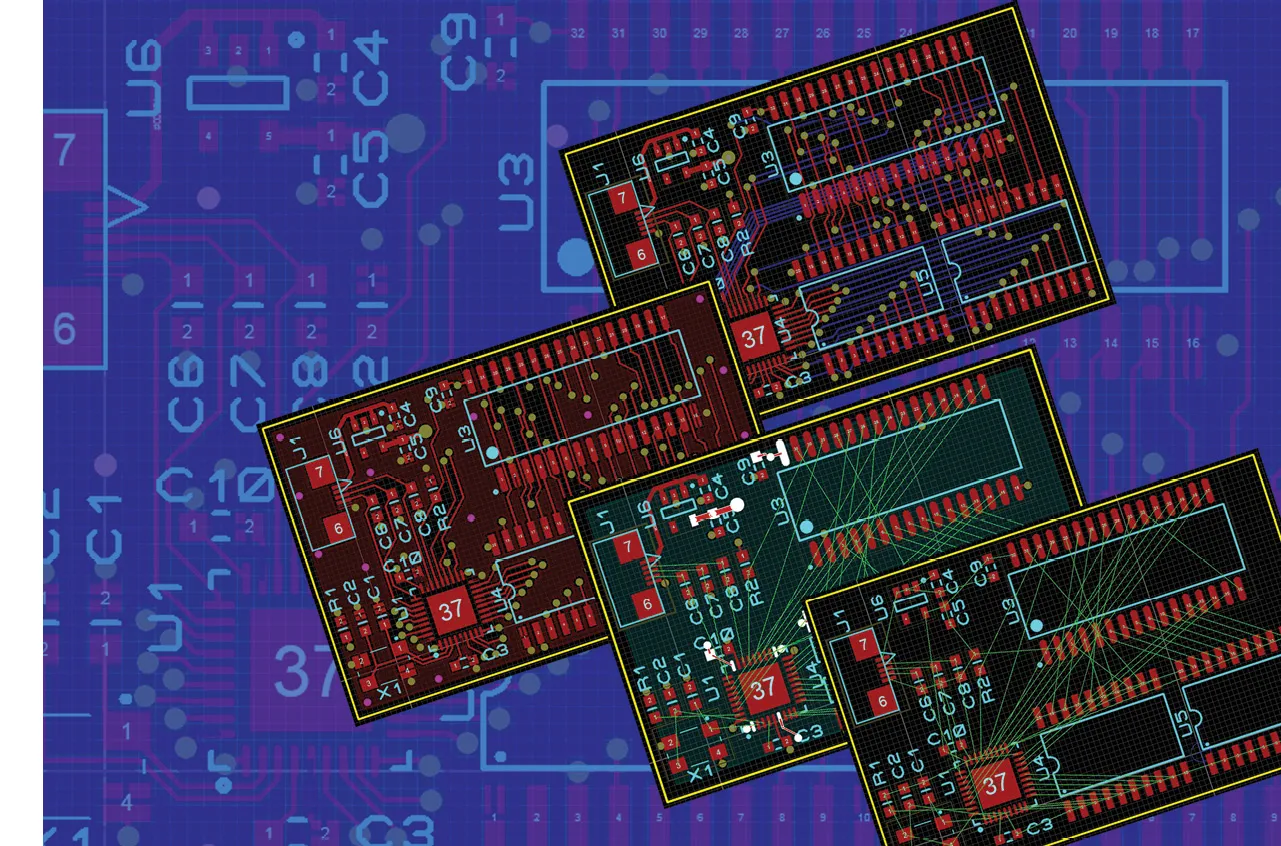
Chapitre 7

Considérations sur les Plans de Masse et d'Alimentation
Les plans de masse et d’alimentation sont essentiels dans la conception de PCB, servant de colonne vertébrale pour une distribution efficace de l’alimentation et une bonne intégrité du signal. Leur mise en œuvre correcte est cruciale pour optimiser les performances du circuit et réduire les interférences électromagnétiques (EMI).
Rôle des Plans de Masse et d’Alimentation
Intégrité du signal :
Les plans de masse offrent un chemin de retour continu pour les signaux, ce qui aide à minimiser les zones de boucle de signal et réduit l’inductance, maintenant ainsi la fidélité des signaux.
Réduction du bruit :
Les plans de masse et d’alimentation agissent comme des boucliers contre les interférences électromagnétiques. Un plan de masse solide peut absorber et dissiper les EMI générés par divers composants.
Gestion thermique :
Les plans d’alimentation permettent de répartir efficacement la chaleur sur le PCB, aidant ainsi à la gestion thermique en agissant comme des dissipateurs thermiques pour les composants.
Stabilité de la tension :
Les plans d’alimentation assurent une distribution uniforme de la tension sur la carte, évitant les chutes de tension et garantissant une alimentation stable pour les composants.
Simplification du routage :
En dédiant des couches à l’alimentation et à la masse, le routage des signaux devient plus simple, réduisant la complexité du design et améliorant la fabricabilité.
Comment Utiliser Efficacement les Plans de Masse et d’Alimentation
Utiliser des couches dédiées :
Pour les PCBs multicouches, dédiez des couches entières comme plans de masse et d’alimentation solides. Cette séparation simplifie la gestion des couches et optimise les performances.Minimiser les interruptions :
Évitez de diviser inutilement les plans de masse. Les interruptions peuvent couper les chemins de retour et augmenter les boucles inductives, ce qui pourrait dégrader la qualité du signal et augmenter les EMI.Couturage efficace des vias :
Employez le couturage des vias pour connecter les plans de masse et d’alimentation sur plusieurs couches. Cette technique aide à maintenir un potentiel constant et minimise l’inductance.Optimiser la forme et la taille des plans :
Assurez-vous que les plans de masse et d’alimentation sont suffisamment larges pour gérer les charges de courant attendues. Une taille appropriée prévient la surchauffe et garantit des chemins à faible impédance.Placement des condensateurs de découplage :
Placez les condensateurs de découplage près des broches d’alimentation des circuits intégrés, en les connectant directement aux plans d’alimentation et de masse. Cette approche filtre le bruit de l’alimentation et stabilise la tension.Isoler les masses analogiques et numériques :
Si des composants analogiques et numériques sont présents, utilisez des plans de masse séparés pour éviter que le bruit numérique n’affecte les signaux analogiques sensibles. Connectez-les en un point unique pour éviter les boucles de masse.Division prudente des plans de masse :
Si une division est nécessaire (par exemple, pour différents domaines d’alimentation), assurez-vous que les divisions sont bien définies et que les chemins de retour traversent les divisions avec soin.Vérifications et simulations régulières :
Utilisez des outils de simulation pour vérifier l’intégrité et les performances de vos plans de masse et d’alimentation. Ces outils aident à identifier les points faibles ou les problèmes d’interférences potentiels.
En comprenant et en concevant soigneusement les plans de masse et d’alimentation, vous pouvez considérablement améliorer les performances et la fiabilité des PCBs. Cette approche garantit une bonne intégrité des signaux, réduit les risques liés aux EMI et renforce la stabilité globale du circuit.
Chapitre 8
Gestion Thermique dans la Conception de PCB
Une gestion thermique efficace est essentielle dans la conception de PCB pour garantir que la carte fonctionne de manière efficiente et fiable, en particulier dans les applications à haute puissance. Comprendre comment gérer la chaleur peut prévenir la surchauffe, améliorer les performances et prolonger la durée de vie des composants électroniques.
Comprendre la Gestion Thermique
Importance de la Gestion Thermique :
À mesure que les dispositifs électroniques deviennent plus compacts, la densité des composants sur les PCB augmente, entraînant une consommation d’énergie et une production de chaleur plus élevées. Une gestion thermique efficace garantit que cette chaleur est dissipée correctement pour éviter d’endommager les composants.
Sources de Chaleur dans les PCB :
La chaleur est principalement générée par des composants de puissance tels que les processeurs, transistors de puissance et LED. Une mauvaise gestion de la chaleur peut entraîner un stress thermique affectant l’intégrité physique et les performances de la carte.
Impact d’une Mauvaise Gestion Thermique :
Sans dissipation thermique efficace, les composants peuvent dépasser leurs températures de fonctionnement maximales, entraînant des problèmes tels que la dérive thermique, une efficacité réduite et une défaillance des composants.
Techniques pour Améliorer la Dissipation Thermique dans les PCB
Utilisation de Vias Thermiques (Thermal Vias) :
Intégrez des vias thermiques dans les zones générant beaucoup de chaleur pour transférer la chaleur de la couche supérieure aux couches internes ou au côté opposé de la carte. Cela augmente la surface pour la dissipation thermique.Cuivrage et Dissipateurs Thermiques (Copper Pours and Heatsinks) :
Utilisez des cuivres sur le PCB pour répartir la chaleur de manière uniforme. Pour les composants critiques, fixez des dissipateurs thermiques pour évacuer rapidement la chaleur de la surface.Placement Optimal des Composants :
Positionnez les composants qui génèrent une chaleur importante dans des zones bénéficiant d’un bon flux d’air. Évitez de regrouper les composants chauds, sauf si des méthodes de refroidissement efficaces sont utilisées.PCB Multicouches :
Utilisez des conceptions multicouches pour intégrer des dissipateurs thermiques internes, répartissant efficacement la chaleur sur différentes couches.Tampons Thermiques et Isolateurs (Thermal Pads and Insulators) :
Utilisez des matériaux d’interface thermique comme les tampons thermiques pour améliorer la conduction de la chaleur des composants vers les dissipateurs thermiques ou les couches de la carte.Sélection des Matériaux de la Carte :
Choisissez des matériaux de substrat PCB avec une conductivité thermique élevée. Des matériaux tels que les PCBs à base métallique ou les substrats céramiques peuvent améliorer la dissipation thermique.Intégration de Ventilateurs et Refroidissement Forcé :
Pour les applications à haute puissance, envisagez d’utiliser des solutions de refroidissement actives telles que des ventilateurs pour améliorer le flux d’air sur le PCB.Utilisation d’Outils de Simulation Thermique :
Utilisez des logiciels d’analyse thermique pendant la phase de conception pour prévoir la distribution de la chaleur et identifier les points chauds. Cela permet d’apporter des ajustements dans la disposition ou la stratégie de refroidissement avant la fabrication.
En appliquant ces techniques, les concepteurs peuvent gérer efficacement les défis thermiques dans la disposition des PCB. Cela garantit non seulement une fiabilité opérationnelle, mais optimise également les performances et la longévité des dispositifs électroniques.

Chapitre 9

Test et Débogage de la Disposition de PCB
Techniques pour Tester les Dispositions de PCB Avant la Production Complète
Avant que votre conception de PCB ne passe à la production à grande échelle, il est crucial de tester et de déboguer minutieusement la disposition pour s’assurer qu’elle répond à toutes les spécifications et fonctionne comme prévu. Voici quelques techniques efficaces à considérer :
Test Électrique :
Cela inclut l’utilisation d’équipements de test automatisés pour vérifier les courts-circuits, les circuits ouverts et les valeurs de résistance correctes sur la carte. Ce type de test est essentiel pour confirmer que les connexions électriques sont correctes et fonctionnent comme prévu.Test Fonctionnel :
Simulez les conditions réelles dans lesquelles le PCB fonctionnera pour vous assurer que tous les composants interagissent correctement et que la carte remplit sa fonction prévue.Test In-Circuit (ICT) :
L’ICT consiste à tester les composants du PCB directement sur la carte en utilisant des dispositifs et équipements spécialisés pour des mesures directes. Cela permet d’identifier les défaillances des composants et de s’assurer que chaque partie fonctionne correctement dans le circuit.
Problèmes Courants Lors des Tests de PCB et Comment les Résoudre
Lors des tests de vos dispositions de PCB, vous risquez de rencontrer plusieurs problèmes courants. Voici comment les résoudre :
Problèmes d’Intégrité du Signal :
Des problèmes tels que les interférences croisées, le bruit et les perturbations peuvent affecter les performances de votre PCB. Ceux-ci peuvent souvent être atténués en révisant la disposition pour augmenter l’espacement entre les pistes, améliorer la mise à la terre ou utiliser des techniques de blindage.Problèmes de Distribution d’Alimentation :
Des chutes de tension et une alimentation instable peuvent se produire. La résolution de ces problèmes peut nécessiter l’ajout de plans d’alimentation supplémentaires, l’amélioration du découplage ou la refonte du réseau de distribution d’alimentation.Défaillances des Composants :
Des composants défectueux ou mal installés peuvent entraîner des défaillances. Remplacer les composants et vérifier les procédures d’installation lors de la phase d’assemblage peut résoudre ces problèmes.
Outils pour un Débogage Efficace des Dispositions de PCB
Des outils de débogage efficaces sont essentiels pour identifier et résoudre les problèmes dans vos dispositions de PCB. Voici quelques outils essentiels qui peuvent faciliter le processus de débogage :
Oscilloscopes :
Utilisez un oscilloscope pour observer visuellement les signaux électriques dans le circuit. C’est un outil précieux pour tracer les problèmes d’intégrité du signal et de synchronisation.Multimètres :
Essentiels pour mesurer la tension, le courant et la résistance, les multimètres aident à confirmer que chaque partie de votre PCB fonctionne dans ses paramètres prévus.Analyseurs Logiques :
Pour les circuits numériques plus complexes, les analyseurs logiques peuvent capturer et afficher les signaux numériques dans votre PCB, aidant à tracer les problèmes dans les flux de données numériques et les interfaces.Caméras Thermiques :
Elles peuvent être utilisées pour identifier visuellement les points chauds sur le PCB, indiquant les zones où les composants électriques peuvent surchauffer ou où il pourrait y avoir un flux de courant excessif.
En utilisant ces techniques et outils de test et de débogage, vous vous assurez que votre disposition de PCB est non seulement optimisée pour les performances, mais également suffisamment robuste pour gérer ses applications prévues. Cette approche minutieuse des tests et du débogage améliore non seulement la fiabilité de votre produit final, mais rationalise également le passage du prototype à la production, vous faisant gagner du temps et des ressources à long terme.
Chapitre 10
Tendances Futures dans la Conception de PCB
Alors que la technologie évolue rapidement, le domaine de la conception des PCB progresse continuellement pour répondre aux nouvelles exigences en matière de performance, de miniaturisation et de fonctionnalités. Suivre les tendances émergentes aide les ingénieurs et les concepteurs à anticiper les défis futurs et à innover en conséquence.
Technologies Émergentes dans la Conception de PCB
Électronique Flexible et Extensible :
Les PCBs flexibles, fabriqués à partir de matériaux comme le polyimide, permettent de plier et de tordre sans compromettre la fonctionnalité. L’électronique extensible représente l’évolution suivante, permettant une intégration dans les technologies portables et les dispositifs médicaux.
Composants Intégrés :
L’intégration de composants passifs (résistances, condensateurs) et actifs (circuits intégrés) dans les couches du PCB permet d’économiser de l’espace, d’améliorer les performances électriques et de renforcer la solidité mécanique.
PCBs à Interconnexion Haute Densité (HDI) :
À mesure que les appareils deviennent plus petits, les PCBs HDI, avec des largeurs de pistes plus fines et des microvias, prennent en charge une densité de composants plus élevée et un routage amélioré, essentiels pour les gadgets modernes.
Impression 3D et Fabrication Additive :
La fabrication additive permet la création de structures 3D complexes au sein du PCB, ouvrant de nouvelles possibilités de miniaturisation et de conceptions multicouches auparavant inaccessibles.
Matériaux Avancés :
De nouveaux matériaux de substrat, tels que la céramique ou les composites avancés, offrent des propriétés thermiques et électriques supérieures, permettant de meilleures performances dans les applications haute fréquence et haute puissance.
Prévisions pour les Innovations Futures dans les PCB
Intégration avec IoT et IA :
Les PCBs futurs s’intégreront davantage aux appareils IoT et aux algorithmes d’IA, en intégrant directement des capteurs et des capacités intelligentes sur la carte pour améliorer la connectivité et la puissance de traitement.
Utilisation Croissante de l’Apprentissage Automatique :
Les algorithmes d’apprentissage automatique pourraient optimiser les processus de conception des PCBs, de la disposition au routage, en prédisant les goulots d’étranglement et en suggérant automatiquement des configurations optimales.
Accent Accru sur la Durabilité :
Avec la montée des préoccupations environnementales, les PCBs futurs privilégieront les matériaux écologiques et les processus de fabrication durables, notamment la recyclabilité et la réduction des déchets.
Intégration avec l’Informatique Quantique :
Avec le développement de l’informatique quantique, les PCBs devront répondre à des exigences uniques, telles que des environnements cryogéniques et une intégrité de signal précise pour les qubits.
PCBs Biodégradables et Écologiques :
La recherche sur les substrats biodégradables pourrait aboutir à des PCBs qui se décomposent après leur durée de vie utile, réduisant les déchets électroniques et facilitant leur élimination.
Développement de Cartes Multifonctions :
Les PCBs deviendront plus polyvalents, intégrant plusieurs fonctions et capacités telles que des antennes et des modules de communication sans fil directement sur la carte.
Réalité Augmentée (AR) dans la Conception :
La réalité augmentée pourrait révolutionner la conception des PCBs en offrant une visualisation et une manipulation en temps réel des conceptions dans un espace 3D, conduisant à des processus de conception plus intuitifs et sans erreurs.
Solutions Améliorées pour la Gestion Thermique :
Les innovations en gestion thermique relèveront les défis posés par les densités de puissance accrues, utilisant des matériaux à changement de phase avancés et un refroidissement liquide directement intégré aux PCBs.
En explorant ces technologies émergentes et tendances futures, les concepteurs de PCBs peuvent rester à l’avant-garde, garantissant que leurs conceptions sont non seulement robustes et fiables, mais aussi innovantes et alignées sur les besoins futurs du marché.

Contactez-Nous
Où Sommes-Nous ?
Parc Industriel, No. 438 Route Donghuan, No. 438, Shajing Donghuan Road, District Bao'an, Shenzhen, Guangdong, Chine
4ème étage, Bâtiment Zhihui Créatif, No. 2005 Route Xihuan, Shajing, District Baoan, Shenzhen, Chine
CHAMBRE A1-13, ÉTAGE 3, CENTRE INDUSTRIEL YEE LIM, 2-28 RUE KWAI LOK, KWAI CHUNG HK
service@southelectronicpcb.com
Téléphone : +86 400 878 3488
Envoyez-nous un message
Plus vous remplissez de détails, plus nous pourrons avancer rapidement à l’étape suivante.



